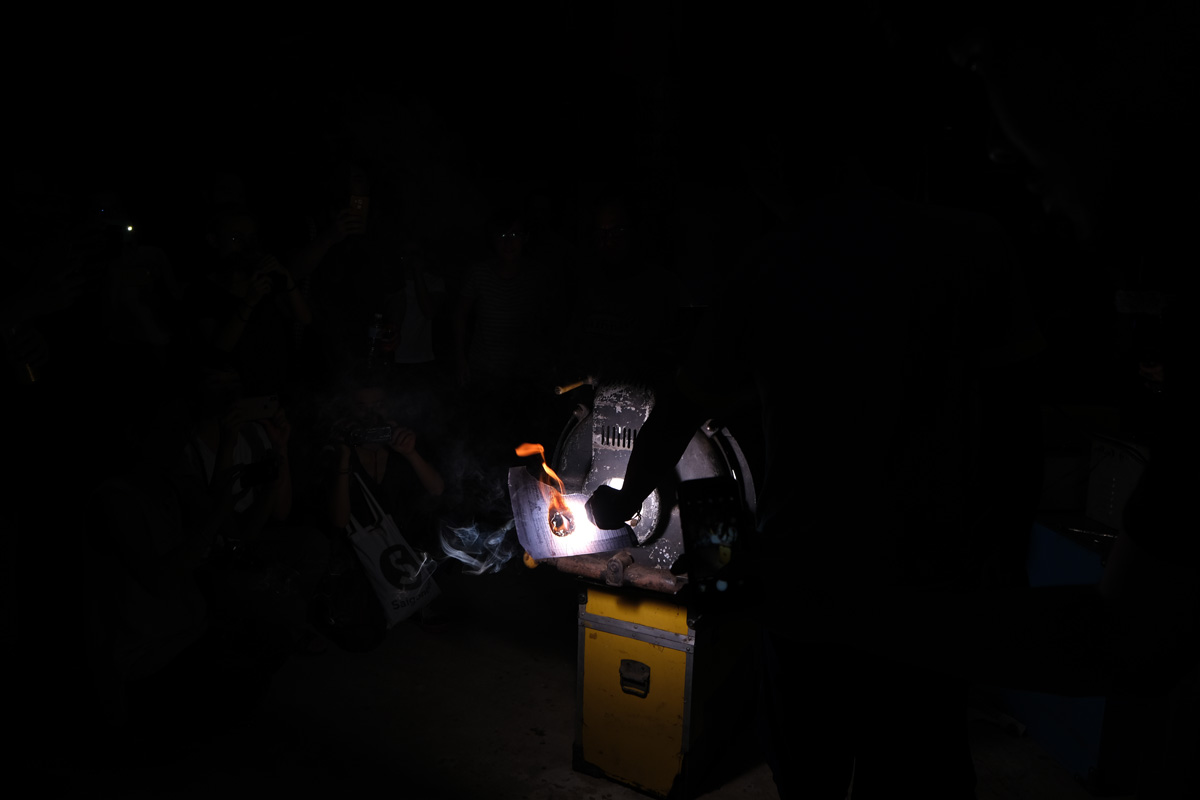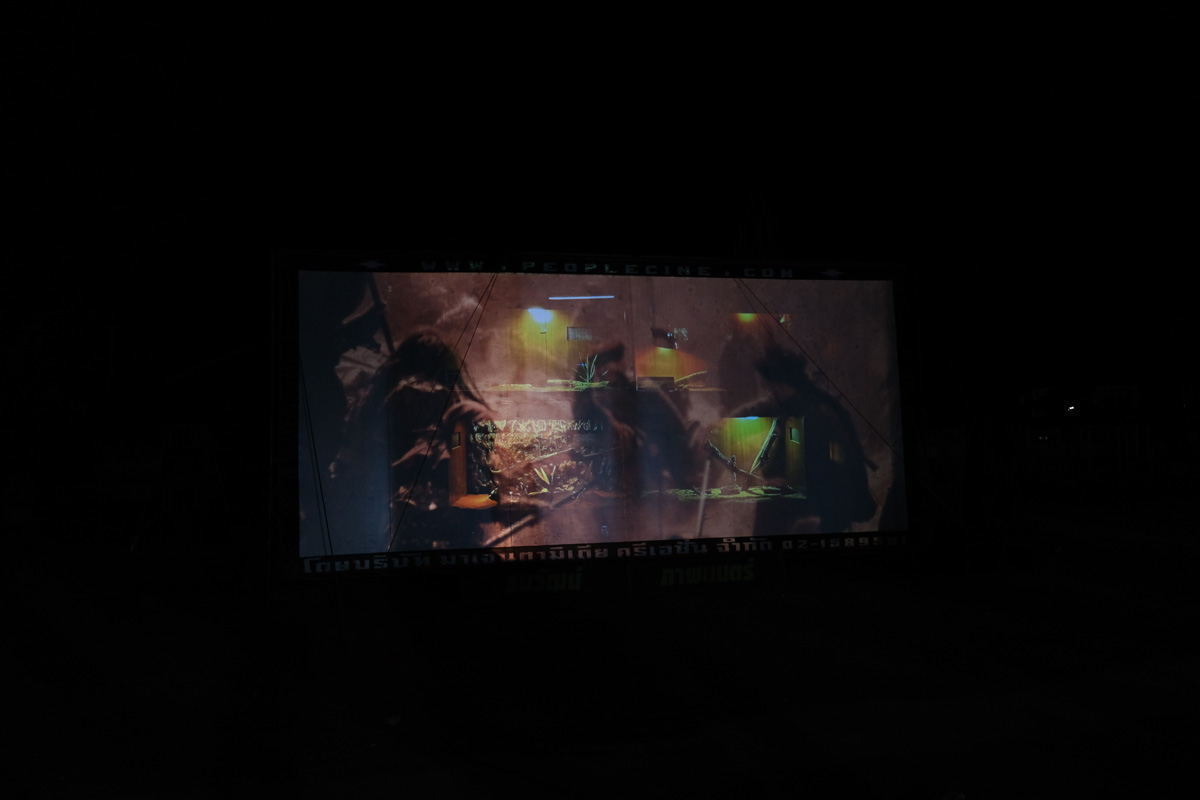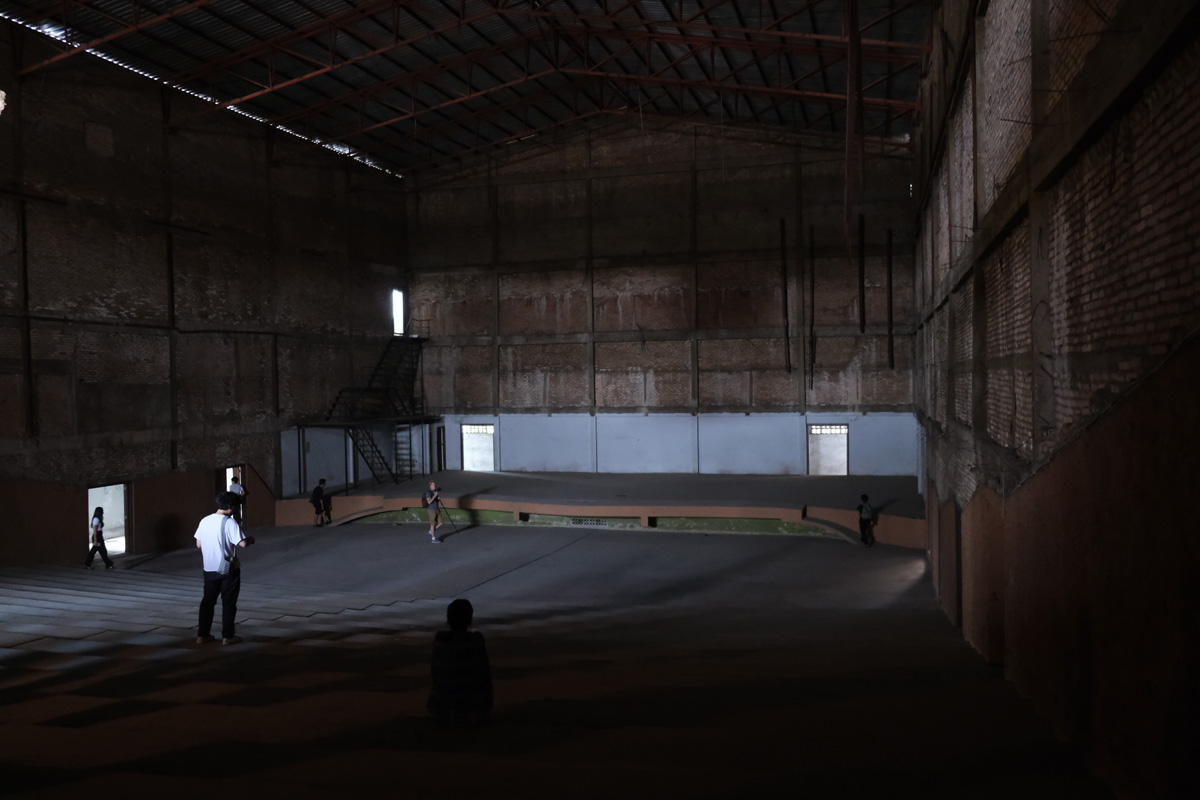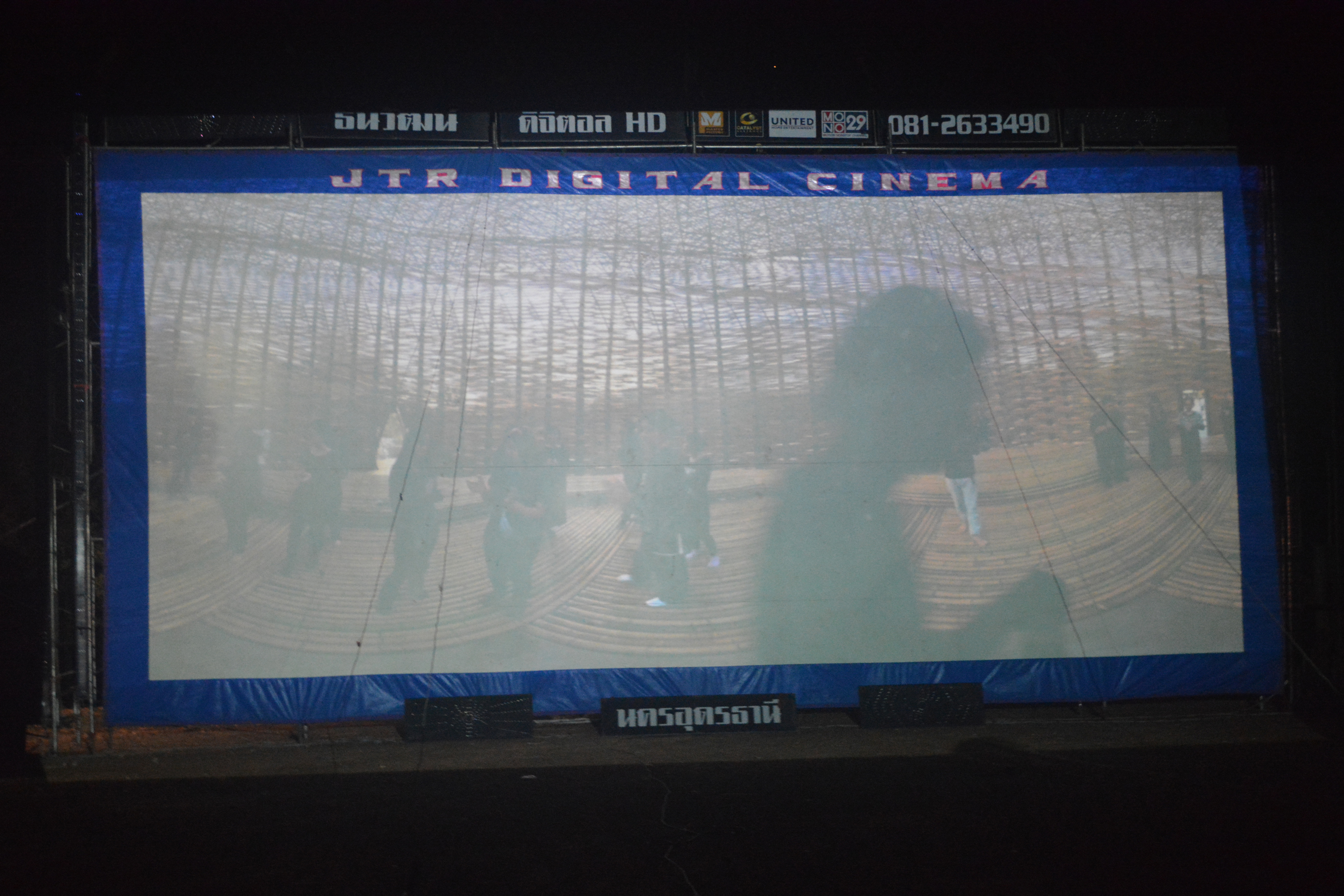WHAT ARE THE RELATIONSHIP BETWEEN STEPHEN YOUNG’S RESEARCH ON BAN CHIANG, ITINERANT MAKESHIFT CINEMA, AND ‘ANIMISTIC APPARATUS’ PROGRAM CO-CURATED BY MAY ADADOL INGAWANIJ AND JULIAN ROSS? OBSERVES KRIDPUJ DHANSANDORS
TEXT: KRIDPUJ DHANSANDORS
PHOTO COURTESY OF ANIMISTIC APPARATUS
(For English, please scroll down)
โครงการลองของ (Animistic Apparatus) จัดขึ้นในระหว่างวันที่ 21-26 พฤษภาคม 2562 ริเริ่มโดยอาดาดล อิงคะวณิช อาจารย์ด้านทฤษฎีภาพเคลื่อนไหว จาก Centre for Research and Education in Arts and Media (CREAM) University of Westminster ประเทศอังกฤษ ร่วมกับ CLOUD และ Noir Row Art Space โดยในวันที่ 21 เมษายน 2562 ได้มีการงานเสวนา และโปรแกรมฉายภาพยนตร์ภายใต้ชื่อ Animistic Apparatus: Screening ที่สมาคมฝรั่งเศสกรุงเทพ มีภัณฑารักษ์คืออาดาดล ร่วมกับ Julian Ross ภัณฑารักษ์จากอัมสเตอร์ดัม ประเทศเนเธอร์แลนด์

หลังจากนั้นโครงการก็ได้ยกขบวนศิลปินไปที่จังหวัดอุดรธานี เริ่มเช้าด้วยการไปสักการะศาลปู่หนองจอก ไปพบกับนิธิวิทย์ ธานินทร์สุรวุฒิ ผู้เก็บรักษาม้วนฟิล์มภาพยนตร์ ไปเยี่ยมชมโรงภาพยนตร์วิสต้า ข้างทุ่งศรีเมือง ที่ปิดตัวลงแล้วกว่ายี่สิบปี และได้เปิดสนามทดลองครั้งแรกที่วัดศรีทัศน์ บ้านหนองนาคำ ต.หนองนาคำ อ.เมืองอุดรธานี ก่อนจะปิดท้ายด้วยการจัดสนามประลองศิลปะภาพและเสียงอย่างยิ่งใหญ่ในสองคืนสุดท้ายที่ริมบึงนาคำ ต.บ้านเชียง อ.หนองหาน จ.อุดรธานี ผู้เขียนในฐานะผู้ร่วมโครงการได้ตั้งข้อสังเกตถึงความสัมพันธ์บางอย่างระหว่างการศึกษาแหล่งโบราณคดีบ้านเชียง การทำวิจัยสังคมศาสตร์ของ Stephen Young การฉายหนังกางแปลงและโครงการลองของ
การค้นพบวัฒนธรรมยุคสำริดบ้านเชียง ต.บ้านเชียง อ.หนองหาน จ.อุดรธานี ถือว่าเป็นหนึ่งในการค้นพบที่ยิ่งใหญ่ทางโบราณคดีศึกษาและถูกผนวกรวมให้เป็นส่วนหนึ่งของชาติไทยอย่างน่าฉงน นักโบราณคดีสันนิษฐานว่าชาวบ้านอยู่กันอย่างสงบ แต่ละชุมชนมีลวดลายเครื่องปั้นที่แตกต่างกัน มีเทคโนโลยีที่พัฒนาขึ้นเองในท้องถิ่น (Localism) หาได้เป็นสังคมที่ล้าหลังที่เพียงแต่รับความเจริญจากภาพนอก เช่น จีนหรืออินเดีย มีสังคมแบบไม่รวมศูนย์ ซึ่งต่างจากตะวันออกใกล้ที่พบโลหะที่บ่งบอกถึงสังคมแบบรัฐ มีกษัตริย์ มีการสู้รบ Maurizio Peleggi ได้เสนอว่าการถกเถียงถึงเรื่องช่วงเวลาของบ้านเชียงยังคงดำเนินต่อไป และเป็นการอำพรางความจริงที่ว่าอเมริกาเข้ามาตั้งฐานทัพจำนวนมากในประเทศไทยเพื่อทำสงครามเวียดนาม

หลังสิ้นสุดสงครามโลกครั้งที่สอง สหรัฐฯ ได้ให้ความสนใจประเทศไทยและมีความกังวลอย่างมากว่าจะเกิดสงครามคล้ายกับเวียดนาม สหรัฐฯ พ่ายแพ้เพราะขาดความรู้ทางด้านสังคมวิทยาในภูมิภาคเอเชียตะวันออกเฉียงใต้ จึงได้เกิดโครงการเข้ามาศึกษาในภาคอีสานและภาคเหนือ ซึ่งในช่วงนั้นพื้นที่บริเวณภาคตะวันออกเฉียงเหนือเป็นแหล่งซ่องสุมของเหล่าคอมมิวนิสต์จำนวนมาก และยังถูกใช้โดยสหรัฐฯ เพื่อทำสงครามต่อสู้กับคอมมิวนิสต์ในประเทศลาวและเวียดนาม

จุดเริ่มต้นของการศึกษาค้นคว้าวิจัยบ้านเชียงแท้จริงแล้วเริ่มตั้งแต่ พ.ศ. 2503 เมื่อชาวบ้านพบภาชนะลายเขียนสีและกระดูกมนุษย์ และได้ตั้งพิพิธภัณฑ์ของตนเองขึ้นมา นักโบราณคดีหัวหน้าหน่วยศิลปากรจังหวัดขอนแก่นได้รับมอบโบราณวัตถุจากชาวบ้านแต่ก็มิได้ดำเนินการใดๆ ต่อมาในปี พ.ศ. 2509 Stephen Young นักศึกษามานุษยวิทยาจาก Harvard University ลูกของ Kenneth Young เอกอัคราชฑูตสหรัฐฯ ประจำประเทศไทยในขณะนั้น ได้ไปสำรวจเพื่อศึกษาวิจัยชีวิตชาวลาวพวน ซึ่งถูกกวาดต้อนจากเวียงจันทร์ มาบริเวณ อ.หนองหาน จ.อุดรธานี สมัยรัชกาลที่ 3 เมื่อสยามทำศึกกับกบฏเจ้าอนุวงศ์
Stephen ยังบังเอิญเดินสะดุดโคนไม้ แล้วเจอเศษภาชนะบ้านเชียง นับเป็นจุดเริ่มต้นให้กรมศิลปากรและ University of Pennsylvania ขุดค้นแหล่งโบราณคดีบ้านเชียง ทั้งนี้ รัชกาลที่ 9 ได้เสด็จพระราชดำเนินทอดพระเนตรการขุดค้นที่บ้านเชียง เมื่อวันที่ 20 มีนาคม พ.ศ. 2515 สอดคล้องกับงานของปราการ กลิ่นฟุ้งที่เสนอว่าเส้นทางเสด็จฯ ต่างจังหวัดเป็นไปอย่างต่อเนื่องและทวีความสำคัญในช่วงภัยคอมมิวนิสต์

บ้านเชียงกลายเป็นกรณีตัวอย่างของความสัมพันธ์ไทย-สหรัฐฯ ช่วงสงครามเย็นมีนักวิชาการสหรัฐฯ เข้ามาจำนวนมาก มีการพยายามสร้างให้ไทยเป็นศูนย์กลางการศึกษาโบราณคดีของเอเชียตะวันออกเฉียงใต้เพื่อสนับสนุนปฏิบัติการณ์ต่อต้านการเผยแพร่ลัทธิคอมมิวนิสต์ ดร.จอยซ์ ไวต์ นักโบราณคดีบ้านเชียงคนสำคัญเคยให้สัมภาษณ์ว่า “โดยรวมแล้ว ส่วนใหญ่เป็นสถานการณ์ win-win ทั้งไทยและสหรัฐฯ ต่าง ‘ให้และรับ’ จากกันและกัน”
วิทยานิพนธ์และเอกสารของ Stephen Young ได้ถูกการเก็บรักษาไว้ที่พิพิธภัณฑ์บ้านเชียง มีเอกสารสามชิ้นที่น่าสนใจและสามารถอธิบายภาพบรรยากาศการเมืองในช่วงนั้นได้เป็นอย่างดี ได้แก่ จดหมายของ Stephen Young เขียนถึงครอบครัวของตนเอง เมื่อวันที่ 12 สิงหาคม ปี ค.ศ. 1965 เอกสารชิ้นที่สองคือวิทยานิพนธ์ของเขาชื่อ The Northeastern Thai Village: A Non-Participatory Democracy เอกสารชิ้นที่สามคือภาพวาดที่เขาใช้ในการสัมภาษณ์ทัศนคติของชาวบ้าน

ในช่วงเวลานั้น Stephen มีความสนิทสนมกับราชวงศ์ไทย จอมพลสฤษดิ์ ธนะรัตช์ และนักธุรกิจระดับบน เขาสนับสนุนแนวคิดทุนนิยมอย่างมีจริยธรรม ตามแนวคิดของ Aristotle ที่เน้นเรื่องคุณธรรม และไม่สนับสนุนประชาธิปไตย เอกสารทั้งสามชิ้นต่างบ่งบอกว่าเขายังมีทัศนคติคล้ายกับนักวิจัยอเมริกันในช่วงนั้นคือมองว่าหมู่บ้านถูกประดิษฐ์ขึ้นเป็นส่วนหนึ่งของชาติ กลายเป็นหน่วยของการวิเคราะห์ทางมนุษยศาสตร์ เป็นหน่วยของการพัฒนารัฐในสายตารัฐ หมู่บ้านเต็มไปด้วยความขัดแย้ง และยากจน สุ่มเสี่ยงกับการถูกชักจูงโดยคอมมิวนิสต์
ช่วงเวลานั้นเองที่ภาพยนตร์ถูกใช้เป็นเครื่องมือในการประชาสัมพันธ์ชวนเชื้อโดยรัฐผ่านการฉายหนังกางแปลง หน่วยฉายหนังประจำจังหวัด หรือที่เรียกว่า “หน่วย ปจว.” ฉายหนังเพื่อสร้างอุดมการณ์ชาตินิยมและสร้างความเกลียดชังคอมมิวนิสต์ เช่น เหตุเกิดที่บ้านโพนไฮ หรือเพื่อมาตุภูมิ ผ่านการสนับสนุนจากยูซิส (สำนักข่าวสารอเมริกัน)
ดังนั้นแล้วโครงการลองเปิดโอกาสให้ศิลปินปฏิบัติการไม่ต่างจากนักวิจัยสำรวจพื้นที่ในจังหวัดอุดรธานี นับตั้งแต่ความเชื่อสิ่งลี้ลับในชุมชน ประวัติศาสตร์ของหนังกางแปลงที่ล้มหายและฟื้นคืนหลังละครนาคี โรงภาพยนตร์อิสระที่เติบโตพร้อมกับการเข้ามาของกองทัพสหรัฐฯ และหายไปเมื่อโลกเข้าสู่ยุคดิจิตัล ไปจนถึงวัฒนธรรมกรรมวิธีย้อมผ้าของชาวลาวพวนบ้านเชียงอพยพ รวมถึงการปั้นหม้อลวดลายที่เลียนแบบตามโบราณวัตถุที่ค้นพบ วัตถุศึกษาเหล่านี้ได้ผลิดอกออกผลมาเป็นการสร้างสรรค์งานศิลปะ (บางคนก็นำผลงานเดิมของตนมาแสดงเพื่อเล่นล้อกับบริบทแวดล้อม) ทั้งภาพเคลื่อนไหว เสียง การแสดงสด หรือแม้กระทั่งงานเขียนที่ผู้เขียนกำลังทำอยู่นี้

อาจกล่าวได้หรือไม่ว่ากระบวนการสร้างงานศิลปะหลายรูปแบบภายใต้โครงการลองของ ผู้มีอำนาจหรือความชอบธรรมที่จะพูดในนามของความรู้ หรือที่ Foucault เรียกว่า discoursing subjects ด้วยการกำหนดขอบเขตของการศึกษา สถาปนาชุดภาษา ไวยากรณ์และคำอธิบายที่เฉพาะตัว เพียงแต่การศึกษาชนบทในช่วงสงครามเย็นเป็นการทำให้ชาวบ้านเป็นวัตถุของการศึกษามากกว่าที่จะสนใจเชิงวัฒนธรรม เพื่อการพัฒนาเทคโนโลยีให้แก่ภูมิภาคที่จำกัดความว่า “ด้อยพัฒนา”
โครงการฉายภาพยนตร์ ภาพเคลื่อนไหว เสียงสังเคราะห์ และการแสดงสดที่เกิดขึ้นตลอดค่ำคืนวันที่ 24-26 พฤษภาคม 2562 ที่ผ่านมา คงต้องยอมรับว่าพื้นที่ของการสื่อสารผลงานกับคนในชุมชนจะยังค่อนข้างจำกัด แม้ว่าจะเป็นการฉายกลางแปลง แต่ศิลปะจากโลกตะวันตกมิใช่สิ่งที่จะเข้าถึงสู่ชุมชนได้โดยง่าย อย่างภาพยนตร์เรื่อง พัฒนากร (พ.ศ. 2506) อำนวยการสร้างโดยยูซิส ยังต้องใช้หมอลำในการชวนเชื่อ จะเห็นว่าชาวบ้านบ้านเชียงให้ความสนใจกับการแสดงสดหมอลำแบงค์และหมอแคนบัวตองอย่างคึกคัก หรือการฉายภาพยนตร์อีสานกระแสหลักหลังจากที่ศิลปินได้คืนพื้นที่ให้กับชาวบ้าน ลานหน้าจอหนังต่างถูกจับจองอย่างรวดเร็ว

อย่างไรก็ตามโครงการนี้ยังได้เผยให้เห็นถึงเรื่องเล่าที่ไม่ถูกนับรวมในประวัติศาสตร์กระแสหลัก เช่น การค้นพบโบราณวัตถุบ้านเชียงครั้งแรกและก่อตั้งพิพิธภัณฑ์โดยชาวบ้านเอง และพื้นที่ทับซ้อนจนทำให้เส้นพรมแดนรัฐชาติถูกท้าย เช่น ตำนานปู่ช้างดำที่เป็นทหารลาวเสียชีวิตในบริเวณศาลที่ต่อมาถูกทำให้เป็นส่วนหนึ่งของรัฐไทย ชุมชนโบราณบ้านเชียงราวสามพันปีก่อนที่ถูกผนวกรวมเป็นส่วนหนึ่งของชาติไทยที่เพิ่งกำเนิดไม่ถึงร้อยปี ตำนานเจ้าหญิงลาวที่ตัวตนได้กลายสถานะจากผีอาฆาตเป็นพญานาค จากความกลัวของชาวบ้านเป็นความเคารพศรัทธา และตำแหน่งสิ้นพระชนม์ไม่แน่ชัดระหว่างไทยหรือลาว
พร้อมๆ กันโครงการลองของก็ได้ตั้งคำถามมากมายถึงสถานะของสื่อภาพยนตร์ที่ประพฤติตนมิได้เพียงเพื่อติดต่อระหว่างมนุษย์ไปถึงมนุษย์ ไม่ว่าจะเพื่อผลิตซ้ำวาทกรรมหรือความเชื่อ แต่การฉายภาพยนตร์ครั้งหนึ่งยังเกิดการปะทะสังสรรค์กับระบบนิเวศแวดล้อม ฝนฟ้าอากาศที่ต้องมีพิธีกรรมขอขมาเจ้าที่ กำลังไฟฟ้าจากเขื่อนประเทศลาวที่ไม่เพียงพอกับการฉาย สิ่งศักดิ์สิทธิ์ผู้ปกป้องผืนดินบางท่านที่ไม่ชอบภาพยนตร์ ช่างเกษมที่ถูกว่าจ้างให้มาเป็นทั้งครูและช่างเทคนิคในการฉายหนัง ศิลปินนานาชาติที่ยกขบวนมาจากเมืองหลวง ร้านค้าหลากหลายเรียงราย สุนัขที่เดินเข้ามาระหว่างการแสดงสด หรือการที่มีชายหนุ่มในพื้นที่นั่งชมการทดลองในมุมมืดเพียงลำพังจนจบสิ้นกิจกรรม

คงต้องย้อนกลับไปถึงหนังสือ Staying with the Trouble (2016) ทำให้เราเข้าใจได้ถึงปฏิสัมพันธ์ระหว่างมนุษย์และสิ่งที่มิใช่มนุษย์ เครือข่ายขนาดใหญ่เหมือนหยากไย่แมงมุมที่เราต่างมีโซนสัมผัสอย่างหละหลวมต่อกันและกัน เราต่างวิวัฒนาการร่วมกัน การกลับไปเผชิญหน้ากับธรรมชาตินั้นมิใช่เรื่องง่าย กลับน่าพรั่นพรึงและสุ่มเสี่ยง แต่การถอยห่างจากธรรมชาติ หรือการแยกขาดระหว่างธรรมชาติวัฒนธรรมแน่นอนว่าเป็นสิ่งที่เลวร้ายกว่า
การเป็นนักเล่าเรื่องที่เอาตำนานหรือประวัติศาสตร์หยิบขึ้นมาพูดถึงใหม่เป็นสิ่งที่สำคัญที่จะช่วยผสานรอยแยกระหว่างธรรมชาติวัฒนธรรม และแน่นอนว่าโครงการนี้ก็อาจเปรียบได้กับการสร้างเรื่องเล่าใหม่ของอาดาดลและคณะศิลปินที่อาจหาญและท้าทาย จุดหมายเพื่อสำแดงให้เห็นอีกด้านของประวัติศาสตร์ ความทรงจำ และความเกี่ยวโยงของสรรพสิ่ง

Titled ‘Animistic Apparatus’, the art project, which was held between the 21st and 26th May 2019, had May Adadol Ingawanij, moving image theorist and professor of the Centre for Research and Education in Arts and Media (CREAM) University of Westminster, England, together with CLOUD and Noir Row Art Space as the initiators. A talk and screening program, ‘Animistic Apparatus: Screening’, took place on the 21st of April 2019 at Alliance Française Bangkok, with Ingawanij and Amsterdam-based, Julian Ross who was in charge of the curatorial direction.
The project then took the artists on a trip to Udon Thani province where they paid respect to Pu Nhong Jok Shrine and met with Nitwit Thaninsurawut, the collector of film rolls before visiting the old Vista Cineplex, the once thriving venue that has been closed for over twenty years, situated next to Thung Sri Mueng piazza. The first experimental ground of the project was Wat Sri That Temple, Bann Nong Na Kham, Nhong Oakham sub-district of Udon Thani. The project’s memorable closing event featured a battle of visual and sound art, spanning over two nights on the public ground near Beung Nakham Lake of Bann Chiag sub district, Nong Han district in Udon Thani province. As a participant of the project, I’ve made some observations about the connections I found between the study of Ban Chiang archaeological site, Stephen Young’s social science research, the outdoor cinema screening and Animistic Apparatus project.
The discovery of Ban Chiang Bronze Age culture in the area of Ban Chiang sub district, Nong Han district in Udon Thaini province is considered to be one of the greatest archaeological findings, which has been intriguingly included as a part of the Tai history. The objects that were found led archaeologists to believe that the people in the area had been living in peace with each community, and developed specific patterns for its own pottery. Presumably, each locality had developed its own technology and wasn’t exactly a backward society whose development was influenced merely by China or India. The social structure is believed to be de-centralized, differentiating Ban Chaing from other communities within the eastern region with evidence indicating the state-run communities with ruling kings and battles. Maurizio Peleggi proposes that the debate over the age of Ban Chaing’s archaeological discovery was continued as an attempt to conceal the US Army setting up a massive operation base in Thailand during the Vietnam War.
After the end of the Second World War, the United States shifted its interest to Thailand with the growing concern over the possibility of the country entering into the Vietnam War scenario that left the leader of the new world order defeated, primarily due to its lack of a true sociological knowledge in the Southeast Asian region. A project was initiated to conduct studies on the northern and northeastern region of Thailand, which were the areas that served as a massive home base for a growing number of communist enthusiasts. During this particular time period, the area served as the US Army’s regional headquarter as its war against Communism in Laos and Vietnam intensified.
The beginning of the researches and studies of Ban Chiang can be dated back to 1960, when villagers accidentally found and excavated a number of painted pottery and human skeletons, leading to the establishment of a locally-run museum. When the archaeologist who was the head of the Fine Arts Department at Silpakorn University was informed about the excavated objects, no action had yet been taken. Later in 1966, Stephen Young, an anthropology student from Harvard University, the son of Kenneth Young, the US Ambassador of Thailand at the time, went on a survey trip to study the life of the Lao Puan people who expatriated from Vientiane and settled in Nong Han district of Udon Thani province during the reign of King Rama 3, when Siam was at war with King Anuwong’s rebellion.
Stephen Young was exploring the area and stumbled on a fallen tree trunk, accidentally leading him to discover the Bann Chiang pottery. It sparked the interest that caused the Fine Arts Department and University of Pennsylvania to begin the excavation of the Ban Chiang archeological site which commenced on 20th March 1972. The information corresponds with Prakan Klinfoong’s work, which proposes an observation that the King’s plan to visit the country’s rural area was continually carried out and emphasized during the rise of Communism, which was already regarded as a serious threat to the kingdom.
Ban Chiang became a case study of the Thai-US relationship during the Cold War period, with a considerable number of American academics travelling to Siam with an attempt to turn the country into the hub of Southeast Asian archeological studies and as a plan to provide additional support to the US’ Anti-Communism agenda.
There are three documents from Stephen Young’s thesis and Ban Chiang archive kept at Ban Chaing Museum that can be used to describe the political climate of Thailand at the time. The documents include a letter Young wrote to his family (dated 12th August 1965), his thesis is titled ‘The Northeastern Thai Village: A Non-Participatory Democracy’ and the drawings he used when conducting interviews with the locals.
The documents reveal Young’s close relationship with the Thai Royal Family, Field Marshall Sarit Thanarat and prominent Thai businessmen. It also exposes that Young was an advocate of moral-led Aristotelian capitalism but not democracy. The three documents bear witness to his attitude, which was common among American researchers at the time on how these local villages were invented as a part of the nation’s identity, consequentially serving as a unit in humanities analysis as much as it was a unit within the state-initiated and regulated development—painting a scenario of rural villages full of conflict, poverty which were at risk of being indoctrinated by Communist beliefs.
It was during this particular time when film was used as an apparatus for the state to publicize and propagandize its political agendas. Through travelling outdoor cinema screening by the provincial cinema-screening unit known as the ‘Por Wor Jor Unit’, films with messages promoting nationalist ideologies and hatred towards Communism such as ‘At Ban Pon Hai’ or ‘For the Sake of the Motherland’ were made accessible to the locals with the support of USIC (United States Intelligence Community).
What this project, Animistic Apparatus does is that it enables an opportunity for artists to operate similarly to what researchers have been doing in the area of Udon Thani province. It ranges from observing and exploring superstitious beliefs in local communities, the history of outdoor cinema screening that which was once perished and has been making a promising return since the popularity of television drama, ‘Nakee’, the rise of independent movie houses that took place alongside the arrival of the American Army and their disappearance, as a result of the vehement progress of the Digital Era, all the way to the culture behind the traditional dyeing method of Lao Puan expats in Ban Chiang and the making of pottery whose patterns mimic those of the excavated objects from the archaeological site. These objects were blossomed into the artists’ artistic creations (some used their old works to parody with the surrounding context of the site) from moving images, sound and performance art, to writing (this article is also considered to be one the products of these antiquities).
Can it be said that the processes from which these different forms of art are created, under the Animism Apparatus project are similar to those who are given the power and justification to speak in the name of the knowledge? (or what Foucault refers to as discoursing subjects). Such an attempt has been executed through the establishment of educational framework, a specific set of language, grammatical rules and definitions. The only difference is the studies on the rural localities carried out during the Cold War were primarily treating and turning the locals into a research subject; an object that was being studied rather than treated as a culture, in order to cater to the justified supply of technical developments to the region whose state-provided definition was ‘underdeveloped’.
The film screening and exhibitions of moving images, synthesized sounds and performance art, which took place throughout the three nights (24th – 26th May 2019) was still, unfortunately, rather limited in terms of the way the works were communicated to the audience. Despite being an outdoor event, art work from the West still isn’t something that can be easily accessible to the locals and vice versa. Films such as Pattanakorn (1963) produced by USIC still needed to rely on the use of local folk songs or Mo Lam in order to get the propaganda across. To prove that point, the locals’ interest in Mo Lam live performance by performers (stage names: Mo lam Bank and Mo Lam Bua tong) today is still evident during the screening of mainstream Esan film, which took place after the artists gave back the public space to the local events, received eager interest from the locals as the seats were being reserved quickly.
Nevertheless, the project has revealed the untold stories that have never been included in mainstream history. Few of the examples range from the first discovery of Ban Chiang and the establishment of the local-run museum to the overlapping territorial claims caused by the myths about the death of Laotian elephant soldier Pu Chang Dam and the shrine constructed as a result of the incident which led to the area being included as a part of the Thai state, or the fact that the three thousand year old community such as Ban Chiang has been assimilated to the history of Thailand – the nation whose official origin goes back only less than a century ago. There is also a legend of a Laotian princess who went from being a grudge-bearing spirit to the sacred Naga, (mythical serpent-like creature) whose place of death still remains undermined, as the locals’ fear evolves into faith.
Throughout its course, the project raiseed a number of questions about the status quo of film as a medium that does not only help humans communicate through either reproduced discourses or beliefs, but the fact that the travelling outdoor screenings have also brought the dynamic clashes between the different unites within the area’ social-ecological system, from rituals carried out to respectfully deviate forces of nature, the imported power that turned out to be insufficient to accommodate the screening, the land protectors who are cinema lovers, Kasem, the local expert hired to be both the instructor and screening technician, a group of international artists who travelled from the city, shops, kiosks and food carts, dogs walking around the outdoor cinema to a young man sitting all by himself through the entire experimental activity of the project.
It goes back to Staying with the Trouble (2016), the book that grants us a better understanding on human / non-human interactions. Within the massive spider-web like network, we are loosely intertwined, evolving collectively. Going back to confront nature isn’t easy. It’s something we dread and feels risky. But distancing ourselves from nature or disconnecting nature from culture is definitely worse.
Being a storyteller who retells legends and history is significant, for it enables the crack between nature and culture to be mended. And without a doubt, this project can be compared to the Ingawanij and the artists’ attempt to create new stories. It’s brave and challenging and it aims to reveal another side of history, memories and the interconnection of all things.

